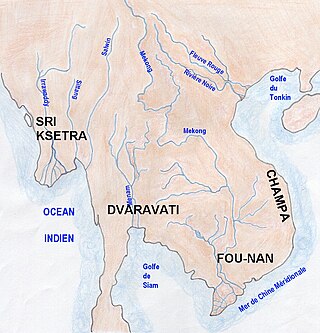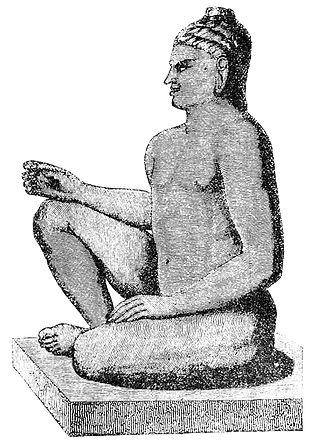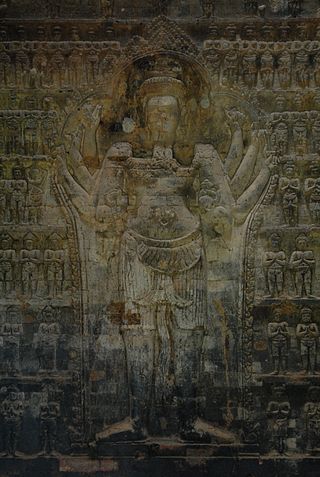Related Research Articles

Khmer architecture, also known as Angkorian architecture, is the architecture produced by the Khmer during the Angkor period of the Khmer Empire from approximately the later half of the 8th century CE to the first half of the 15th century CE.

Angkor, also known as Yasodharapura, was the capital city of the Khmer Empire, located in present-day Cambodia. The city and empire flourished from approximately the 9th to the 15th centuries. The city houses the Angkor Wat, one of Cambodia's most popular tourist attractions.

Funan was the name given by Chinese cartographers, geographers and writers to an ancient Indianized state—or, rather a loose network of states (Mandala)—located in mainland Southeast Asia covering parts of present-day Cambodia, Thailand and Vietnam that existed from the first to sixth century CE. The name is found in Chinese historical texts describing the kingdom, and the most extensive descriptions a name the people of Funan gave to their polity. Some scholars argued that ancient Chinese scholars has found the records from Yuán Shǐ, the history records of Yuan Dynasty. "Siem Kok and Lo Hu Kok, formerly the Kingdom of Funan, were located to the west of Linyi Kok. The maritime distance was from the capital of Linyi Kok to the capital of Funan Kok. They are separated by about 3,000 li."

Kampong Thom is a province (khaet) of Cambodia. It borders the provinces of Siem Reap to the northwest, Preah Vihear to the north, Stung Treng to the northeast, Kratie to the east, Kampong Cham and Kampong Chhnang to the south, and the Tonle Sap to the west.

Chenla or Zhenla is the Chinese designation for the successor polity of the kingdom of Funan preceding the Khmer Empire that existed from around the late 6th to the early 9th century in Indochina. The name was still used in the 13th century by the Chinese envoy Zhou Daguan, author of The Customs of Cambodia. It appears on the Mao Kun map. However, modern historiography applies the name exclusively to the period from the late 6th to the early 9th century. This period of Cambodian history is known by historians as the Pre-Angkor period. It is doubted whether Chenla ever existed as a unitary kingdom, or if this is a misconception by Chinese chroniclers. Most modern historians assert that "Chenla" was in fact just a series of loose and temporary confederations of principalities in the pre-Angkor period.

Yasovarman I was an Angkorian king who reigned in 889–910 CE. He was called "Leper King".
Jayavarman I, also called Protégé of Victory, is considered to be the last ruler of the united Chenla, the predecessor polity of the Khmer Empire.
Jayavarman II was a Khmer prince who founded and became the ruler of the Khmer Empire (Cambodia) after unifying the Khmer civilization. The Khmer Empire was the dominant civilization in mainland Southeast Asia from the 9th century until the mid-15th century. Jayavarman II was a powerful Khmer king who declared independence from a polity inscriptions named "Java", which most probably refers to the island of Java in the Indonesian archipelago. Jayavarman II founded many capitals such as Mahendraparvata, Indrapura, Amarendrapura, and Hariharalaya. Before Jayavarman II came to power, there was much fighting among local overlords who ruled different parts of Cambodia. The most well known opposition were the Shailendra Kings. In 781, Jayavarman II took action by claiming independence on the land of Chenla. By starting off with small weak kingdoms, he built himself up from there eventually leading to the Khmer Empire. No inscriptions by Jayavarman II have been found. Future kings of the Khmer Empire described him as a warrior and the most powerful king from that time frame that they could recall. Historians formerly dated his reign as running from 802 AD to 835 AD.

The khloy is a traditional bamboo vertical duct flute from Cambodia and more specifically the Khmer people. The khloy and other similar bamboo flutes can be found throughout Asia, due to bamboo’s abundance in the region. The khloy is a duct flute and has two sizes: smaller, higher-pitched and larger, lower-pitched. It has six finger holes and a thumb hole, or seven finger holes and no thumb hole. A hole above the highest finger hole may be covered with a membrane made of rice paper or bamboo inner skin, similar to di mo.
Bhavavarman I or Phraya Kalavarnadishraj was a king of Chenla, which would later become the Khmer Empire.
Mahendravarman was also called Protégé of the Great Indra.

Ak Yum is an ancient temple in the Angkor region of Cambodia. Helen Jessup dates the temple to the 8th century, and states it is the oldest known example of "temple mountain" in Southeast Asia.

Ishanavarman II was an Angkorian king who is believed to have ruled from 923 to 928. His empire may have been confined to Angkor and the area around Battambang to the west.
Jeyavarman IV was an Angkorian king who ruled from 928 to 941 CE. Many early historians thought that he was a usurper. However, recent evidence shows that he had a legitimate claim to the throne. During his reign, the nation had 12 cities or pura.

Sambor Prei Kuk (Isanapura) is an archaeological site in Cambodia located in Kampong Thom Province, 30 km (19 mi) north of Kampong Thom, the provincial capital, 176 km (109 mi) east of Angkor and 206 km (128 mi) north of Phnom Penh. The now ruined complex dates back to the Pre-Angkorian Chenla Kingdom, established by king Isanavarman I as central royal sanctuary and capital, known then as "Isanapura". In 2017, Sambor Prei Kuk was declared a UNESCO World Heritage Site.
A Dharmasala or a house of fire, or house with fire, is the name given to a place where people, especially pilgrims, can rest on a journey. It is a type of building found in Angkorian complexes constructed during the reign of late 12th-century monarch Jayavarman VII and still found in Preah Khan, Ta Prohm and Banteay Chhmar.
Isanapura, also known as Sambhupura or Sambor of St'ung Sen, was the capital of the ancient kingdom of Chenla. It is located in what is now Kampong Thom Province in Cambodia. The city was founded in about 618 at Leek Sambor Kuk by King Isanavarman I. According to Paul Pelliot, Sambhupura was the capital of Land Chenla.
Traditional Cambodian medicine comprise several traditional medicine systems in Cambodia.
Bhavavarman II was King of the Chenla Kingdom, predecessor polity of the Khmer Empire, from 639 to 657.
Viravarman was the king of Chenla.
References
- 1 2 Coedès, George (1968). Walter F. Vella (ed.). The Indianized States of Southeast Asia. trans.Susan Brown Cowing. University of Hawaii Press. ISBN 978-0-8248-0368-1.
- ↑ Higham, C., 2014, Early Mainland Southeast Asia, Bangkok: River Books Co., Ltd., ISBN 9786167339443
- ↑ Kenneth T. So. "Preah Khan Reach and The Genealogy of Khmer Kings" (PDF). Cambosastra. Retrieved 2 March 2017.
- ↑ “Coedès‟ Histories of Cambodia”.page 11.
- ↑ BEFEO 1904.page 693.
- ↑ Higham, C., 2001, The Civilization of Angkor, London: Weidenfeld & Nicolson, ISBN 9781842125847
- ↑ "Rinith Taing, "Was Cambodia home to Asia's ancient 'Land of Gold'?", The Phnom Penh Post, 5 January, 2018". Archived from the original on 6 June 2020. Retrieved 17 September 2024.
- ↑ Gaudes, Rüdiger (1993). "Kauṇḍinya, Preah Thaong, and the "Nāgī Somā": Some Aspects of a Cambodian Legend". Asian Folklore Studies. 52 (2): 333–358. doi:10.2307/1178160. ISSN 0385-2342. JSTOR 1178160.
- ↑ Bakker, Hans (2009). "The So-called 'Jaunpur Stone Inscription of Īśānavarman". Indo-Iranian Journal. 52 (2/3). Brill: 208. doi:10.1163/001972409X12525778274224. JSTOR 24664699.
- Bulletin de l'École française d'Extrême-Orient 1904 - BEFEO 1904
- Vickery, Michael. (2000) "Colloque George Coedès aujourd‟hui". Bangkok, Centre d‟Anthropologie Sirindhorn, 9–10 September 1999.
Published as “Coedès‟ Histories of Cambodia”, in Silpakorn University International Journal (Bangkok,), Volume 1, Number 1, January–June 2000, pp. 61–108.
- Vickery, Michael. (1998). "Society, economics, and politics in pre-Angkor Cambodia: the 7th–8th centuries." :Centre for East Asian Cultural Studies for Unesco. ISBN 9784896561104
- Marr, David G./ Millner, A. C./ Gungwu, Wang (1986). "Southeast Asia in the Ninth to Fourteenth Centuries.". ISBN 9971988399
- Majumdar, Ramesh Chandra. (1980). "Kambuja-Deśa: or, An ancient Hindu colony in Cambodia." :Institute for the Study of Human Issues. ISBN 0915980282